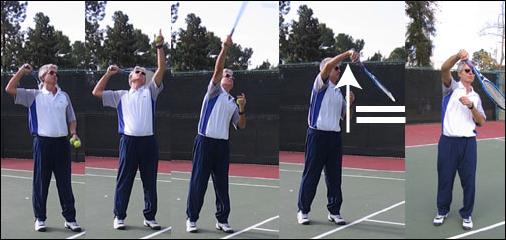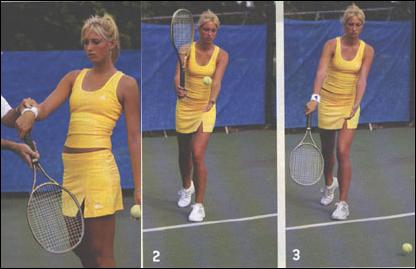Revolutionary Tennis |
||
Tennis Instruction That Makes Sense |
||
WRIST SNAP SERVE DRILL The wrist is too delicate to fool around with, any isolation exercise must be approached with caution because it can easily be strained. If you literally isolate the wrist the range of motion used would be small, as in wrist curls with weights or squeezing an object in your hand. Isolating the wrist for a tennis serve must be done within the context of the serve itself. This way you can avoid injury while developing muscle memory for how it is to be used in real form. Objective: increase wrist snap, its use and familiarity. Goal: from your service line snap the wrist to bring the ball into the opposite service box. Method: open your stance, bring the back foot around to simulate an open forehand groundstroke (protecting your shoulder since you will not be shifting body weight or swinging fully to assist), and place the racket behind you and down the back (the back-scratch position). Relax the wrist and arm. Toss the ball, no need for a "perfect" toss here. Swing up and aggressively snap the wrist but STOP the racket immediately after the snap to isolate the wrist snap - keep the arm/hand/wrist up (the arrow) and the racket points down and stops moving (the two parallel lines). Pause after contact in this position for memory, arm remains very bent.
Undoubtedly you won't get the ball in the opposite service box at first, but soon you will. You'll notice how you need to stop hitting the ball for length and instead need to stop the arm in order to spank it down into the court. In so doing you will be reinforcing the arm's configuration at contact - the crooked position - and the application to achieve this configuration. This drill, or any other wrist drill for a tennis serve, can be murder on the wrist. Proceed with caution, and hit only a few balls. After you can snap the ball down into the box a few times please stop the drill and return to the baseline and apply this element at the end of a full serve with a full swing. TENNIS magazine had a "Serve" issue, March, 2005. Pros Nick Saviano and Brenda Schultz-McCarthy's advice proved spot-on, but celebrity teacher Rick Macci's contribution on improving the wrist snap, hitting what he calls "wristers," raised my eyebrows.
He writes: "Start with a bow in your hitting wrist... Lean forward slightly at the waist... toss the ball in front of you and bend your wrist back and snap the ball down using only your wrist... you want the ball to make a loud sound and a high bounce." Rick's student shows his ideas. Feel free to try it out if you want, and you can decide which method better reinforces the wrist snap from an overhead position for a tennis serve, which method makes more sense. [Macci photos TENNIS, march, 2005, photos by Manuela Davies/PROPIX] Serve main page. Back to where you were.
|
||
|
|
||||||||||||||||||||||||||||||||||||||||||||||||||||||||||||||
 This emphasizes a singular wrist movement. It is a single-plane snap, not a multi planar snap, because you are not hitting up and for distance and power and getting it in. But you need to get the hang of loosening the wrist and of isolating only this movement (which occurs within a host of others).
This emphasizes a singular wrist movement. It is a single-plane snap, not a multi planar snap, because you are not hitting up and for distance and power and getting it in. But you need to get the hang of loosening the wrist and of isolating only this movement (which occurs within a host of others).
